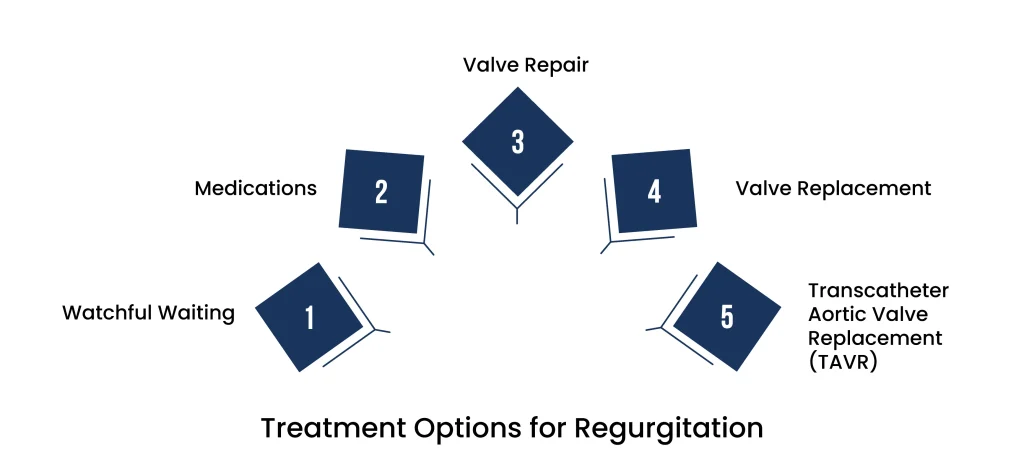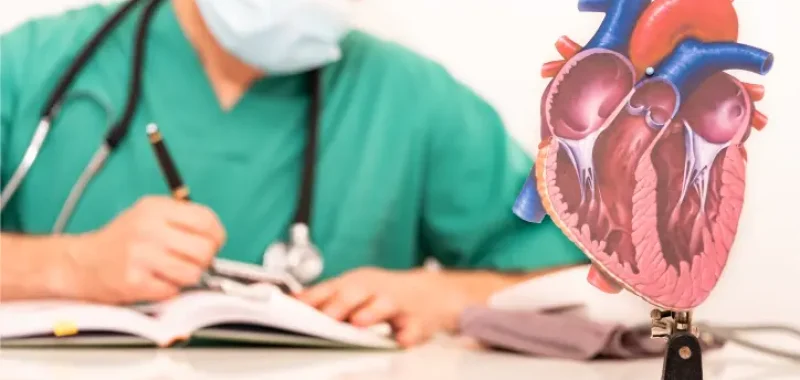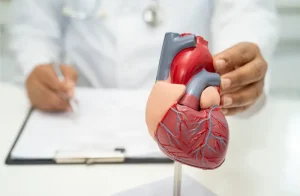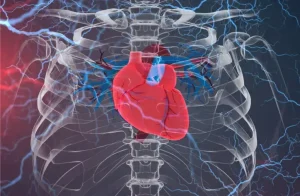You might not give much thought to your heart valves, but these tiny flaps play a crucial role in keeping your blood flowing in the right direction. When they don’t work correctly, it can lead to two common problems: stenosis and regurgitation.
These might sound like complex medical terms, but understanding them could be crucial for your heart health. Stenosis is when a valve narrows, like a clogged doorway, while regurgitation is like a leaky door, allowing blood to flow backward.
In this blog post, we’ll explain the difference between stenosis and regurgitation, explore the specific ways they affect each of your heart valves, and explore the symptoms, causes, and treatment options. Whether you’re simply curious about how your heart works or have been diagnosed with a valve issue, this guide will provide valuable insights.
So, let’s open the door to understanding these common heart valve disorders and empower you with knowledge for a healthier heart.
What Is Stenosis?
Stenosis is a condition in which a heart valve becomes narrowed or constricted. Imagine a partially blocked doorway—it becomes harder to pass through. This is similar to what happens in your heart when a valve experiences stenosis.
Normally, heart valves open fully to allow blood to flow forward, then close tightly to prevent it from leaking backward. But when a valve is stenotic, it doesn’t open completely, restricting the amount of blood that can pass through. This forces your heart to work harder to pump blood, which can eventually lead to fatigue, shortness of breath, chest pain, and other symptoms.
Stenosis can affect any of the four heart valves
1. Aortic Stenosis (AS):
What it is: The aortic valve, the gateway between your heart’s main pumping chamber (left ventricle) and the aorta (your body’s largest artery), becomes narrowed.
Common causes: In older adults, calcium deposits on the valve are the most frequent culprit. Younger individuals may have a congenital bicuspid aortic valve (two leaflets instead of three).
Symptoms: The classic triad is chest pain, fainting, and shortness of breath, particularly with exertion. Fatigue, heart palpitations, and swelling in the feet/ankles can also occur.
Dangers: Untreated, AS can lead to heart failure, irregular heart rhythms (arrhythmias), and sudden cardiac death.
2. Mitral Stenosis (MS):
What it is: The mitral valve, situated between the left atrium (upper chamber) and left ventricle, becomes thickened and less flexible.
Common causes: Rheumatic fever (a complication of strep throat) is a significant risk factor, especially in developing countries. Other causes include calcium buildup and congenital abnormalities.
Symptoms: Initially, MS may be silent. As it progresses, fatigue, shortness of breath (especially lying down), coughing up blood, and a rapid, irregular heartbeat can develop.
Dangers: If untreated, MS can cause high blood pressure in the lungs (pulmonary hypertension), heart failure, and stroke due to blood clots.
3. Tricuspid Stenosis (TS):
What it is: The tricuspid valve, located between the right atrium and right ventricle, becomes narrowed.
Common causes: TS is rare but can be caused by rheumatic fever, carcinoid tumors (hormone-producing tumors), radiation therapy to the chest, and certain medications.
Symptoms: Fatigue, discomfort in the right upper abdomen, swelling in the legs/feet, and a fluttering sensation in the neck are common.
Dangers: Untreated TS can result in right-sided heart failure, arrhythmias, and liver problems.
4. Pulmonary Stenosis (PS):
What it is: The pulmonary valve, controlling blood flow to the lungs, becomes restricted.
Common causes: PS is often congenital, meaning people are born with it. Less commonly, it can be caused by carcinoid syndrome or rheumatic fever.
Symptoms: In mild cases, there may be no symptoms. Severe PS can cause fatigue, shortness of breath, chest pain, and fainting.
Dangers: If severe, PS can lead to right-sided heart failure and arrhythmias.
What is Regurgitation?
While stenosis is about narrowed doorways, regurgitation is a different kind of valve malfunction. It’s like a door that doesn’t close properly, allowing whatever passed through to sneak back in. In the case of your heart, regurgitation means a valve doesn’t seal tightly after blood flows through, causing some blood to leak backward.
This backflow of blood forces your heart to work harder, pumping the same blood multiple times. Over time, this extra workload can strain your heart and potentially lead to various symptoms and complications.
Similar to stenosis, regurgitation can affect any of the four heart valves:
1. Aortic Regurgitation (AR):
- What it is: The aortic valve, meant to be a one-way exit for blood leaving the heart, doesn’t close tightly. This allows blood to leak back into the left ventricle after each heartbeat.
- Common causes: The valve leaflets may be damaged due to conditions like endocarditis (infection), rheumatic fever, or connective tissue disorders. In some cases, the aorta itself may be dilated, pulling the valve apart.
- Symptoms: Many people with mild AR have no symptoms. As it worsens, you might experience fatigue, shortness of breath, lightheadedness, palpitations, and chest pain. In severe cases, AR can lead to heart failure.
- Dangers: The constant backflow stresses the left ventricle, causing it to enlarge and weaken over time. This can lead to heart failure, arrhythmias, and in rare cases, sudden cardiac death.
2. Mitral Regurgitation (MR):
- What it is: The mitral valve, which regulates blood flow between the left atrium and left ventricle, fails to close completely, causing blood to leak back into the atrium.
- Common causes: MR can be primary (due to problems with the valve itself, such as mitral valve prolapse or rheumatic heart disease) or secondary (due to problems with the left ventricle, such as a heart attack or dilated cardiomyopathy).
- Symptoms: Often, there are no symptoms in the early stages. As it progresses, fatigue, shortness of breath, palpitations, and swelling in the feet/ankles can develop. You might also hear a heart murmur.
- Dangers: Untreated MR can lead to atrial fibrillation (an irregular heart rhythm), pulmonary hypertension (high blood pressure in the lungs), and heart failure.
3. Tricuspid Regurgitation (TR):
- What it is: The tricuspid valve, located between the right atrium and right ventricle, doesn’t close properly, causing blood to regurgitate back into the atrium.
- Common causes: TR is often secondary to conditions that affect the right ventricle, such as pulmonary hypertension, right-sided heart failure, or a previous heart attack. It can also be caused by infections or certain medications.
- Symptoms: In mild cases, TR may not cause noticeable symptoms. As it worsens, you may experience fatigue, swelling in the legs/feet, abdominal discomfort, and a pulsating sensation in the neck veins.
- Dangers: The persistent backflow can overload the right atrium and ventricle, leading to their enlargement and dysfunction. This can result in right-sided heart failure and arrhythmias.
4. Pulmonary Regurgitation (PR):
- What it is: The pulmonary valve, which controls blood flow to the lungs, doesn’t close completely, allowing blood to flow back into the right ventricle.
- Common causes: PR is often a result of pulmonary hypertension or damage to the valve caused by conditions like endocarditis, carcinoid syndrome, or rheumatic fever.
- Symptoms: Mild PR may not cause symptoms, but as it progresses, you might experience fatigue, shortness of breath, lightheadedness, chest pain, and swelling in the legs/feet.
- Dangers: Over time, the backflow can overload the right ventricle, causing it to enlarge and weaken. This can lead to right-sided heart failure and arrhythmias.
Stenosis vs. Regurgitation: A Head-to-Head Comparison
While stenosis and regurgitation both involve heart valve dysfunction, they are fundamentally different problems with distinct causes, effects, and treatments. Let’s take a closer look at how these two conditions stack up against each other:
| Feature | Stenosis | Regurgitation |
| Definition | Narrowing of the valve opening | Incomplete closure of the valve, leading to backflow |
| Blood flow | Obstructed forward flow | Backward flow (leakage) |
| Primary causes | Calcium buildup, congenital defects, rheumatic fever | Valve prolapse, infections, connective tissue disorders, dilated aorta/ventricle |
| Heart’s response | Works harder to pump blood through the narrowed valve | Works harder to re-pump leaked blood |
| Symptoms (general) | Fatigue, shortness of breath, chest pain, dizziness | Similar to stenosis, plus palpitations, swelling |
| Diagnosis | Echocardiogram, cardiac catheterization, stress tests | Similar to stenosis |
| Treatment | Medications (limited), balloon valvuloplasty, valve repair or replacement | Medications, lifestyle changes, valve repair or replacement |
| Prognosis | Varies depending on severity and valve affected; early intervention is key | Varies depending on severity and valve affected; early intervention is key |
Treatment Options for Stenosis
The good news is that stenosis, while a serious condition, is often manageable with a range of treatment options. The best approach for you will depend on the severity of your stenosis, the specific valve affected, your overall health, and your personal preferences.
For mild stenosis that isn’t causing significant symptoms, your doctor may recommend “watchful waiting.” This means regular check-ups and imaging tests to monitor the progression of the stenosis and make sure it’s not worsening. Lifestyle changes, such as maintaining a healthy weight and exercising regularly, may also be recommended to support heart health.
While there are no drugs that can reverse stenosis, medications can be used to manage symptoms and address underlying conditions. These may include:
Diuretics: To help reduce fluid buildup and swelling.
Blood pressure medications: To control high blood pressure, which can worsen stenosis.
Antiarrhythmics: To manage irregular heart rhythms.
Anticoagulants: To prevent blood clots if you have atrial fibrillation or other risk factors.
The Balloon Valvuloplasty procedure involves threading a catheter with a balloon at the tip through a blood vessel to the narrowed valve. The balloon is then inflated to widen the opening and improve blood flow. Valvuloplasty is often used for mitral and pulmonary stenosis, and sometimes for aortic stenosis in children or adults who aren’t candidates for surgery.
If possible, surgeons prefer to repair your existing valve rather than replace it. This can involve techniques like:
- Commissurotomy: Separating fused valve leaflets.
- Valvuloplasty: Reshaping or patching the valve leaflets.
- Chordoplasty: Repairing or replacing the chordae tendineae (the cords that support the valve).
- Annuloplasty: Tightening the ring around the valve (annulus) to improve its closure.
When repair isn’t feasible, your damaged valve can be replaced with a mechanical or biological valve. Mechanical valves are durable but require lifelong blood thinners. Biological valves don’t require anticoagulants but may need to be replaced after 10-15 years. TAVR is a newer, less invasive option for aortic stenosis. It involves inserting a replacement valve through a catheter, usually via an artery in the groin. TAVR is often recommended for older adults or those with high surgical risk.
Treatment Options for Regurgitation
Similar to stenosis, the treatment options for regurgitation vary depending on the severity of the leak, the affected valve, your overall health, and your individual preferences. Let’s delve into the various approaches:

- Watchful Waiting:
If your regurgitation is mild and not causing any symptoms, your doctor may recommend “watchful waiting.” This entails regular check-ups and imaging tests (like echocardiograms) to monitor the regurgitation and ensure it’s not worsening. Lifestyle changes, such as maintaining a healthy weight, eating a balanced diet low in sodium, and exercising regularly, can also be beneficial for heart health.
- Medications
While there are no drugs that can directly fix a leaky valve, medications can help manage symptoms and address underlying issues contributing to the regurgitation. These may include:
- Diuretics: To reduce fluid buildup and swelling.
- Vasodilators: To relax blood vessels and make it easier for the heart to pump.
- ACE inhibitors or ARBs: To lower blood pressure and reduce stress on the heart.
- Beta blockers: To slow the heart rate and reduce the workload on the heart.
- Anticoagulants: To prevent blood clots if you have atrial fibrillation or other risk factors.
- Valve Repair
When possible, surgeons aim to repair your existing valve rather than replace it. This approach is often preferred as it preserves your natural valve and may not require lifelong blood thinners. Repair techniques vary depending on the valve and the nature of the regurgitation but can include:
- Annuloplasty: Tightening or reinforcing the ring around the valve (annulus) to help it close more effectively.
- Leaflet repair: Reshaping or patching the valve leaflets to improve their closure.
- Chordal repair: Repairing or replacing the chordae tendineae (the cords that support the valve).
- MitraClip: A minimally invasive procedure used for mitral regurgitation, where a clip is inserted to help the valve leaflets close properly.
- Valve Replacement:
If your valve is severely damaged or repair isn’t feasible, your doctor may recommend valve replacement surgery. This involves removing the leaky valve and replacing it with a mechanical or biological valve. Mechanical valves are durable but require lifelong anticoagulation therapy. Biological valves don’t necessitate blood thinners but may eventually need replacement.
- Transcatheter Aortic Valve Replacement (TAVR):
Similar to aortic stenosis, TAVR is a less invasive alternative to traditional open-heart surgery for aortic regurgitation. It involves inserting a replacement valve through a catheter, usually via an artery in the groin.
Final Words
Stenosis and regurgitation are not just medical terms; they are conditions that can significantly impact your heart health. Understanding these valve disorders, recognizing their signs, and seeking timely treatment can make a world of difference in your well-being. Whether it’s a narrowed valve impeding blood flow or a leaky valve allowing backflow, rest assured that various treatment options exist, ranging from lifestyle adjustments to minimally invasive procedures or surgery.
Remember, your heart is a resilient organ, and with proper care, it can continue to serve you well even in the face of these challenges. Don’t hesitate to consult your doctor if you have any concerns about your heart health. They can guide you toward the most appropriate treatment and management strategies, empowering you to lead a full and active life.






